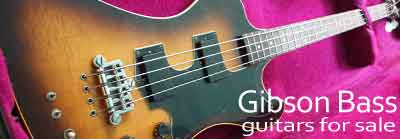Jack's amps
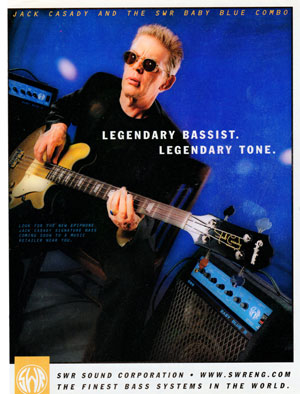
FlyGuitars What amp were you using back in the 60's, was it a Fender?
Jack Casady Yeah, I used a Fender Bassman amp. As a matter of fact an interesting story about that. My father was a dentist but his hobby was electronics and he would do a lot of research on electronics and speaker enclosures. When I started playing bass, even then I apparently liked to play a little louder or use the low end a lot more, and I started blowing out speakers. The Fender Bassman amp was open back; there wasn't a baffle. As a matter of fact that was a very popular amp with steel guitar players and guitar players in general. It just had a certain sound with those four 10 inch speakers. He had a shopsmith in the basement and rec' room which was a combination unit where you could do tooling. It had a circular saw and you could build things and he'd built what was known as the recreation room in the 50's in our basement. He had put a Jenson 15 inch speaker in to a cabinet. He had a Gerrard changer and was a hi-fi buff and built amplifiers. Heathkit was one of the companies that put out hi-fi amplifiers that you could build on your own. As a matter of fact my very first amplifier was an 8 watt Heathkit amplifier he and I built together on the dining room table after dinner every night. He taught me how to do wiring and soldering and the basics of electronics. He said there was some new research about infinite baffles. So he said that by building a cabinet with a baffle and closed back and a port I could control the amount of distance that that speaker cone would move in and out when you hit a low transient note. By controlling that he said you can keep the cone going from to such an extent that it would go beyond its specifications and hurt the cone or voice coil. So he said let me do some calculations for the four ten inch speakers to see how big the cabinet would have to be and (laughs) he came down laughing and he said "well according to my calculations the speaker cabinet that's necessary for these four 10 inch speakers is going to be about the size of the oil furnace downstairs"
FlyGuitars (laughs) oh no
Jack Casady (laughs) He said "Well how about if we make it the size of the back seat of my 1950 Pontiac". So we ended up building this thing together; put the four 10 inch speakers in and put them in a diagonal so left to right, left to right. The 1950 Pontiac was a huge car at the time so this thing was I don't know maybe almost 6 feet long or 5 feet long you know, and about 24/28 inches deep and the same in height. We put some rollers underneath it and I bring it in. I've got a picture of it somewhere and (laughs) it looked like it was about the size of a piano you know. I ran the Bassman top right in to that cabinet and I had a glorious sound and I never blew up another speaker until I got out to California in the 60's. Of course then it didn't matter we played so loud we blew up speakers regularly.
FlyGuitars I'm guessing with a cab that size, the guys in the band weren't too happy lugging it about and lifting it?
Jack Casady Oh yeah, that was the joke at the time you know. They called it The Coffin. In any case, my father taught me that if something wasn't working right, then you take it apart and fix it. That sort of stayed with me and became part of my thinking later on when I started modifying basses, like the old basses in the mid 60's with electronics (see the section on Jack's Guild basses) and working then again with what later on became Alembic; a company that just started out as a bunch of guys some good at electronics, some good at instrument making (see the section on Alembic). Don't forget hi-fidelity and full range sounding systems were something that was just coming in to the market. When it did come in, it was just for the listening of records rather than instrument amplification itself. And now a lot of the circuitry and a lot of the sounds that were for guitar are still good today and a primo 60's amp by Fender or Ampeg or Vox or any of those still holds up better than any virtual version of it you could name today.
FlyGuitars Yes
Jack Casady On the bass end there's very few, and so I think when they started to work with the cabinets more, and the speakers more, the tone got better. Amps were always pretty good. When we started experimenting around '66 with amplifiers and cabinets and the guitars themselves we used a lot of the high grade and high end components that came out of hi-fi equipment as well as later on the space age itself. We started using better grade wiring and better grade speakers and cabinets. We made our own cabinets.
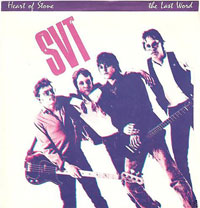
FlyGuitars To an extent musicians like yourself have done all the hard work for us, you've tried out all these things.
Jack Casady The thing is you had the chance to bring something forward to fruition not as the businessman would necessarily, to put it out as a product, but just to experiment. And later on it turned out to be products and of course Ultrasound and a bunch of other companies you know made design patterns and put them out for sale. We used to use Macintosh Amplifiers, you know great hi-fi amplifiers, audiophiles love them. When you wanted to get more bass low end power you know those were the amps that could handle that. I'd take the Macintosh's as a power amp and use a Fender showman top as a pre-amp so you get that grit with the Fender but you get the power coming out of the Macintosh. Now later on Ampeg, once they made their classic SVT amp, that had all that going for it. There were no 300 watt amps out there. I was using SVT's. The name of the band (SVT) wasn't after that. We couldn't really think up a name for the band and we had to come up with something for a gig so rather than call it the Jack Casady Band we called it SVT and that's how it was. I thought the 300 watt classic SVT was, and still is one of the best amp combos made.
FlyGuitars Yes, they are still very well regarded and still used a lot today.
Jack Casady You know I used 8X10's. I always liked the smaller speaker, 10 inch speaker. I used 8 and 10 inch speakers a lot, gives a great sound. But then with that nice big warm sound with the SVT cabinet it was really the amp that was way ahead and as they developed different amps and went in many different directions people come back to that. As an amp that really responds to your playing and really responds well. The kind of music I was playing with SVT I wanted to really go back to a more basic bass approach. I was using a thumb pick and working with a lot of pedal. I'm certainly not a hard rock bassist but for me that was the attempt, to give a less melodic more supporting sound to the tone.
FlyGuitars Talking of Ampeg did you use the Ampeg B15 at all for recording at any point?
Jack Casady Oh yeah, that's a fantastic amp. I used that amp in organ combos where you had sounds like Brother Jack, or Jimmy Smith. In Jazz circles that was used in order to kind of get that big soft boomy walking bass sound. That was a great recording amp for certain styles of music but in the music that we started to play and other bands play you saw people shy away from the emulation of the string bass sound, it gave way to a new sound that was a bass guitar sound.
FlyGuitars Right
Jack Casady And then you had a lot more syncopation on the bass guitar, a lot more notes played in combination with the drums rather than the drums being kind of separate and a walking bass line as was done in Jazz or early Rock 'n' Roll. Once you had James Brown coming in there and more syncopation and what not then you started getting a different kind of bass sound coming out.
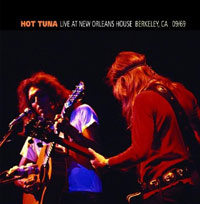
FlyGuitars Can you tell me about the Versatone (Pan-O-Flex) amp?
Jack Casady My engineer turned me on to a little amplifier Carol Kaye was using called the Versatone. She played it on everything but that amplifier was a really sweet little amplifier. It was bi-amped with a couple of 7591's, it was very unusual. You turn it up to 10 o'clock and you just got this really fat warm sound. With the hollow bodied instrument I noticed I got a really nice jazz sound out of it and I was able when I recorded the first Hot Tuna record live at New Orleans House I used the Versatone amp with the Guild Starfire bass. That was the first modified bass.
FlyGuitars I've got that album and I do like the bass tone
Jack Casady That's a very low volume and Jorma was playing his Gibson J50 with a mic in front. The Versatone was a little 35watt amplifier and it was made by Robert Hall who lived in the valley. I visited him and talked to him about them and I ended buying about four of them and using them later on. I used them in a lot of different ways. I discovered if you turned it up to around 1 o'clock, it would start to overdrive and distort. With a solid body it was just kinda like a buzz saw you know but with the hollow body it would rack up and produce the overtones in a perfect fashion I used later on in the Jefferson Airplane sessions. If you listen to Bless This Pointed Little Head, the live sound that's Versatone sound mixed in. I would take that on stage and mic it separately and then use a foot pedal and I'd bleed that in to the sound in the hallway. And I would bleed that in to my regular big sound on stage and that was what we called the sustain like in The Crown Of Creation. So basically I was using the amp as an effects pedal.
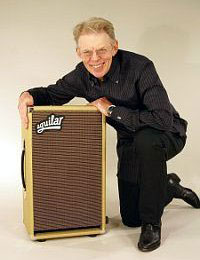
FlyGuitars So what amps do you use now Jack, when you go out playing?
Jack Casady I use an Aguilar set up which I'm very happy with. It's a 700 watt all tube amplifier that they no longer make and they also make a preamp, an all tube preamp that I work in conjunction with a 4x10 cab and that's for the electric setup. The acoustic setup is really a very sweet sound. I worked with Aguilar to develop a cabinet a JC cabinet it's called.
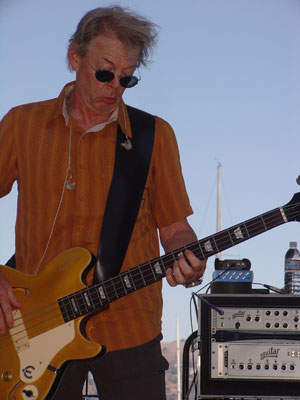
FlyGuitars Are these the compact cabinets?
Jack Casady Two 8 inch speakers and a 5 inch speaker I developed a couple of years ago with them, and I use a George Alisandro? Hound Dog or Bassett Hound amp and that is a very, very sweet sound.
FlyGuitars The compact cabinet that you worked with them on how does that work in terms of the speakers being so close behind each other? To my mind not being technically skilled I would have thought the speakers needed room to move?
Jack Casady Yeah but we're talking about range not loudness. So if you go in to most studios the best studio monitors you'll see are 8 inch speakers. You're not talking about being able to move your pants leg down around your feet
FlyGuitars Right (Laughs).
Jack Casady Don't forget I'm tailoring this to work in conjunction with an acoustic guitar not somebody that's thrashing. Just playing individual notes with fingers on an acoustic
FlyGuitars So it's for a subtler sound?
Jack Casady I can get a full dynamic sound but I don't want a sound that's gonna blast his sound out of the way. It still handles 300 watts but we keep the volume way down on stage and it goes out the front. There's very little volume on stage. If the amp gets to loud on stage it bleeds in to all his stuff and then it makes his low end of the strings sound thin.
Thanks to Graham Fieldhouse and Jack Casady
Further reading: JackCasady.com | HotTuna.com
Guild Starfire bass guitars for sale
1967 Guild Starfire I Red Bisonic Pickup, Player Grade w Original Case
Lee's Summit, Missouri, 640**, UNITED STATES OF AMERICA
$1999
Here's a cool 1967 Guild Starfire I in Cherry Red with the original Hagstrom / Guild Bi-Sonic pickup ??and it absolutely roars. This one is firmly player-grade due to an old headstock repair, but it's stable, functional, and has clearly been holding up well for decades.
Cosmetically, it shows plenty of wear and tear throughout, along with a beat-up original hard case (missing the handle). But the ... more
Vintage 1974 Guild HB1 Humbucker Pickup From Starfire IV Guitar G2U
Bensenville, Illinois, 601**, UNITED STATES OF AMERICA
$275
Guild Starfire Bass 1966
Marino, 00***, ITALY
€3500
... more

